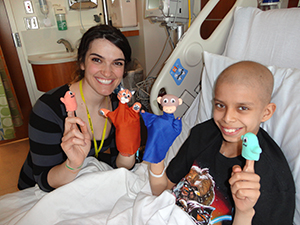Kids embrace art therapy on path to recovery

The therapeutic benefits of creating art have long been recognized.
Some art historians claim that Vincent Van Gogh, whose Van Gogh’s Bedrooms exhibition is currently on display at The Art Institute of Chicago, used art to stay emotionally balanced when struggling with melancholy. They say it was his art that provided him with a sense of well-being and peace during difficult times.
The medical field is no different and has increasingly embraced art therapy in treating patients – both children and adults.

What are the benefits of art therapy?
“Art therapy uses the process of making art to enhance well-being by inviting patients and families to process their feelings and experiences,” says Kate Pfeiffer, an art therapist at Advocate Children’s Hospital, on the benefits of art for hospitalized children and teens. “Oftentimes people are able to make art about feelings they may not be able or willing to speak aloud, such as fear, grief, anger, isolation or even celebration of positive experiences.”
According to a study by the State University of New York College, “Art therapy provides a safe outlet from psychological distress and facilitates recovery.”
Through art, patients are able to tell stories, share feelings and gain a sense of control over their lives.
Much of an art therapist’s work in a children’s hospital setting is devoted to one-on-one time with patients, to enhance their ability to cope with and even thrive through difficult experiences.
“A child I work with may make a splatter painting to express frustration or illustrate a story about an animal that needs to go to the hospital. I’m there to help them work through their thoughts and questions,” says Kate. “I might guide a teen in creating the Chicago skyline on the wall with colored tape in order to help make the hospital environment more welcoming and comfortable.”
Art therapists also work with caregivers and siblings at Advocate Children’s Hospital. A mother may use their time together to make a painting illustrating the love she has for her hospitalized child or one to honor a child she has lost. The sister of a patient with chronic illness might write down her worries and wrap them inside of a cloth “worry doll” so that the doll can hold worries for her. Art therapy programs offer many other services and benefits, also.
”I feel lucky and proud to be able to contribute to the well-being of children and families at Advocate Children’s Hospital,” says Kate. “I also look forward to helping the art therapy program grow and develop.”
Hospital art therapy programs are funded in part by philanthropic donations. These generous gifts allow the programs to expand and enhance services for kids.
If you would like to learn more about supporting Advocate Children’s Hospital Art Therapy program, click here.
Related Posts
Comments
2 Comments
About the Author
health enews staff is a group of experienced writers from our Advocate Health Care and Aurora Health Care sites, which also includes freelance or intern writers.


















I thought you might be interested in this health enews article.
Here is the article. Don’t forget to click through